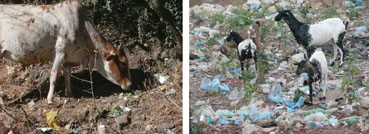22.1 Sources and classification of solid waste
Solid wastes include household refuse, agricultural remnants, food leftovers, plastic bags, tin cans, ash and packaging, such as cartons and used jonya sacks. They become waste once they have been discarded because they are no longer needed in their present form. Refuse, garbage, litter and street sweepings are all terms used to describe solid wastes in various situations.
In rural parts of Ethiopia, the type of solid waste generated will vary depending on the particular location and the socioeconomic and cultural conditions of the area.
In general, rural households produce wastes that are mostly organic in nature and result from agricultural production and processing activities. They include crop residues, food remnants, leaves and grass from clearing of sites, animal manures and dung, ashes, dead animal carcasses, etc. Other solid wastes could include glass, plastic containers, metal scraps, tin cans, plastic bags, condoms and obsolete agricultural pesticides and insecticides. These solid wastes need to be managed properly in a way that avoids the potential risks to the environment and to human health.
The type of waste will determine the choice of possible disposal methods. Therefore, it is important to be able to classify solid waste according to its characteristics (Table 22.1).
As you may remember from Study Session 18, solid waste can be classified based on its source as residential, agricultural, commercial, industrial, institutional or healthcare waste. You were also introduced to the classification of waste as hazardous or non-hazardous and also as biodegradable or non-biodegradable. Another word used in the context of biodegradable solid waste is putrescible, which means the waste decomposes (rots down) quite quickly. Waste can also be described as combustible or non-combustible depending on whether it will burn or not. Table 22.1 classifies waste using these different properties.
| Main classification | Type | Short description | Examples |
|---|---|---|---|
| Hazardous waste | Solid or semi-solid | Substances that are either ignitable, corrosive, reactive, infectious or explosive | Some obsolete pesticides such as DDT, dieldrin, etc. |
| Non-hazardous waste | Putrescible | Easily decomposable/biodegradable solid waste | Food wastes |
| Non-putrescible | Non-biodegradable solid waste, it includes combustible and non-combustible waste | Plastic bags, bottled water containers, tin cans, etc. |
Putrescible wastes are generated by growing, handling, preparation, cooking and consumption of food. These kinds of wastes tend to be more abundant during the summer (rainy) seasons. Non-putrescible wastes do not decompose easily; they may or may not be combustible. Because they do not break down, they persist in the environment and are often the cause of nuisance and aesthetic problems.
Can you think of any non-putrescible wastes that cause environmental problems in your community?
We don’t know exactly what the waste problems are in your area but a probable answer is plastic bags because they are a widespread problem in Ethiopia.
Plastic bags are commonly known as festal. They are widely used to carry goods from market to home in all areas because they are convenient, cheap and easy to use. Plastic bags are usually non-biodegradable and persist in the environment for a very long time. Moreover, when discarded indiscriminately, they pollute the land surface of your community, prevent rainwater from percolating into the soil, can easily be blown all over the place by wind, and create unsightly and nuisance conditions. The bags can also be easily swallowed by animals, which may block their digestive system and kill them (Figure 22.1). In malaria-prone areas, there is also a potential to create breeding places for mosquitoes because the bags may trap small pools of water.

Learning Outcomes for Study Session 22
